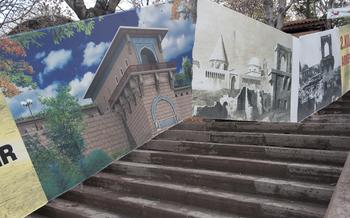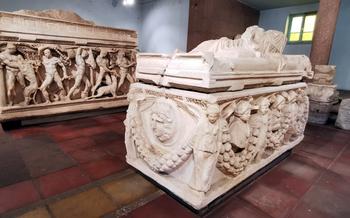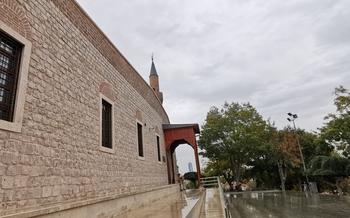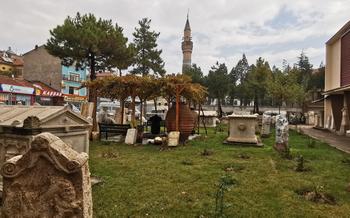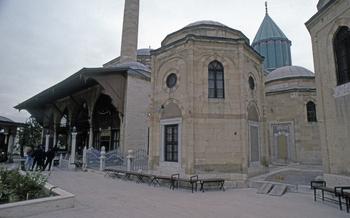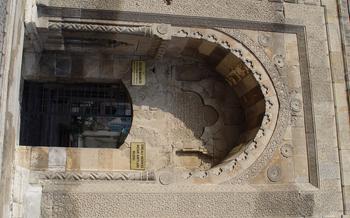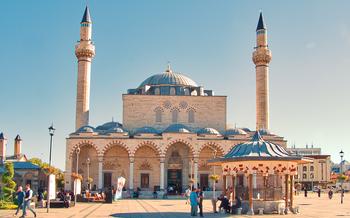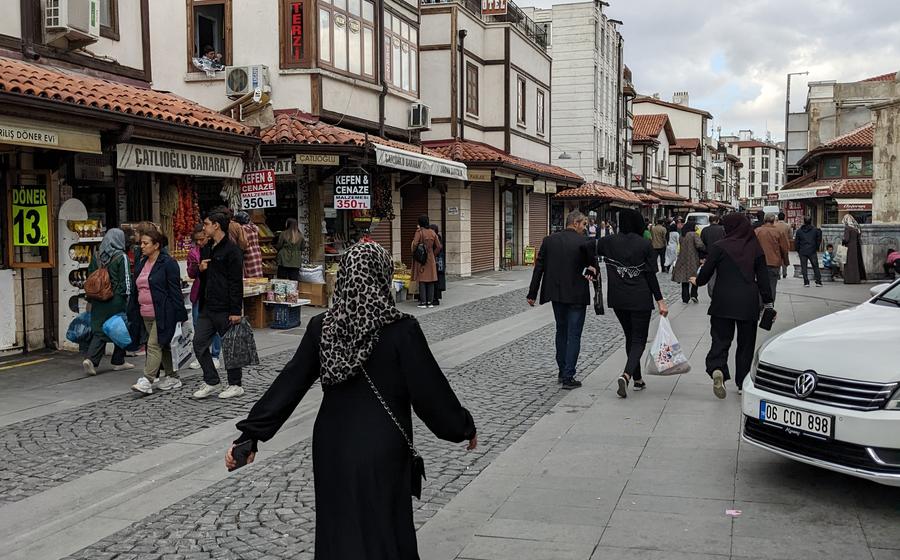
Nasreddin Hoca Ethnography and Archaeology Museum
- Unveiling the Enigmatic Nasreddin Hoca
- Exploring the Nasreddin Hoca Ethnography and Archaeology Museum
- Embarking on a Journey Through Time
- Delving into Hoca's Legendary Tales
- Unveiling Hoca's Sufi Legacy
- Hoca's Global Appeal
- Hoca in Literature and Folklore
- Hoca's Enduring Wisdom
- Interactive Exhibits and Activities
- Guided Tours and Storytelling Sessions
- Educational Programs and Workshops
- Souvenirs and Merchandise
- Insider Tip: Plan Your Visit
Unveiling the Enigmatic Nasreddin Hoca
Nasreddin Hoca, a legendary figure in Turkish culture, is revered as a wise and witty man whose anecdotes have stood the test of time. His tales, often imbued with humor and satire, have been passed down through generations, capturing the imagination of people from all walks of life. The evolution of the Hoca figure over the centuries has seen him transformed from a historical character into a beloved folk hero, embodying the essence of Turkish humor and wisdom.
The cultural significance of Hoca's anecdotes lies in their ability to convey profound truths and life lessons in a simple yet engaging manner. Through his humorous stories, Hoca addresses universal themes such as human folly, social injustice, and the importance of common sense. The enduring relevance of his teachings stems from their timeless appeal, resonating with audiences across cultures and generations.
Exploring the Nasreddin Hoca Ethnography and Archaeology Museum
Located in the heart of Konya, the Nasreddin Hoca Ethnography and Archaeology Museum stands as a testament to the enduring legacy of the beloved folk hero. The museum's captivating exhibits and interactive displays offer visitors a comprehensive and engaging journey through Hoca's life and teachings.
Established in 1977, the museum occupies a historic building that once served as a caravanserai, reflecting the rich architectural heritage of Konya. The museum's mission is to preserve and promote the cultural legacy of Nasreddin Hoca, showcasing his influence on Turkish culture and beyond.
Through collaborative efforts with scholars, cultural institutions, and local communities, the museum has amassed a diverse collection of artifacts, documents, and multimedia exhibits that bring Hoca's world to life. These collaborations contribute to the museum's mission of preserving and interpreting Hoca's legacy for generations to come.
Embarking on a Journey Through Time
The Nasreddin Hoca Ethnography and Archaeology Museum offers an immersive journey through time, allowing visitors to trace the footsteps of the legendary Nasreddin Hoca and discover the cultural heritage of Konya. Interactive exhibits bring Hoca's stories to life, inviting visitors to engage with his humor and wit through multimedia displays. Artifacts from Konya's past provide a glimpse into the daily life and traditions of the region, while interactive displays immerse visitors in the world of Hoca, allowing them to experience his humor and wisdom firsthand.
The museum's collection includes a diverse range of artifacts that shed light on Hoca's life and times. Visitors can examine traditional clothing, household items, and agricultural tools, gaining insights into the daily lives of people in Konya during the 13th century. Interactive exhibits allow visitors to explore the cultural heritage of the region, learning about traditional crafts, music, and dance.
Through interactive exhibits and multimedia displays, the museum brings Hoca's stories to life, allowing visitors to experience his humor and wisdom firsthand. Visitors can watch animated films that depict Hoca's adventures, listen to audio recordings of his tales, and even play interactive games that test their knowledge of Hoca's teachings.
Delving into Hoca's Legendary Tales
Nasreddin Hoca's anecdotes, often referred to as "ficras" or "latife," are not mere jokes or humorous tales. They encapsulate a profound wisdom that transcends time and culture, inviting us to contemplate life's complexities with a blend of humor and insight. Each story, no matter how seemingly simple, carries a hidden moral lesson, a gentle critique of human nature, or a clever commentary on social issues.
Hoca's tales are deeply rooted in the historical context of 13th-century Anatolia, a region marked by cultural diversity and political upheaval. Through his stories, Hoca addresses issues of social injustice, corruption, and hypocrisy, often using satire and irony to expose the follies of those in power. His anecdotes also reflect the challenges and triumphs of everyday life, offering guidance and solace to ordinary people facing similar struggles.
The universal appeal of Hoca's teachings lies in their ability to resonate with people from all walks of life, regardless of their cultural or religious background. His stories transcend geographical and temporal boundaries, speaking to the human condition in a language that everyone can understand. Hoca's humor and wit serve as a bridge, connecting people from diverse backgrounds and inviting them to share in the collective wisdom of his tales.
In today's world, Hoca's fables continue to offer valuable insights into human nature and the complexities of modern life. His teachings remind us of the importance of critical thinking, humility, and compassion. They encourage us to question authority, challenge societal norms, and embrace diversity. By studying Hoca's stories and reflecting on their timeless wisdom, we can find inspiration and guidance for navigating the challenges of our own lives.
Unveiling Hoca's Sufi Legacy
Nasreddin Hoca's connection to Sufism, a mystical branch of Islam, adds a profound spiritual dimension to his teachings and stories. While Hoca was not a Sufi in the traditional sense, his beliefs and teachings were deeply influenced by Sufi principles, particularly the emphasis on simplicity, humility, and the search for inner truth.
Hoca's stories often contain subtle allusions to Sufi concepts such as self-denial, contentment, and the importance of living in the present moment. Through his humorous anecdotes, Hoca conveyed timeless Sufi wisdom in a relatable and accessible manner, making it appealing to people from all walks of life.
Hoca's teachings resonate with the universal principles of Sufism, which emphasize the unity of all creation, the interconnectedness of all beings, and the pursuit of spiritual enlightenment. By weaving these principles into his stories, Hoca invited his listeners to embark on a journey of self-discovery and spiritual growth.
The Nasreddin Hoca Ethnography and Archaeology Museum delves into this aspect of Hoca's legacy, showcasing his connection to Sufism and exploring the influence of Sufi teachings on his stories. Visitors can gain a deeper understanding of the spiritual dimension of Hoca's humor and wisdom, and appreciate the universality of Sufi principles that transcend cultural and religious boundaries.
Through Hoca's stories, visitors can glimpse into the profound spiritual teachings of Sufism and discover the timeless wisdom that continues to inspire and guide people around the world.
Hoca's Global Appeal
The captivating tales of Nasreddin Hoca have transcended the boundaries of Turkish culture, captivating audiences worldwide. Translations of Hoca's anecdotes have been published in over 50 languages, making him one of the most widely-read humorists in the world. Adaptations of his stories have been featured in films, television shows, and stage productions, reaching a global audience.
The universal appeal of Hoca's stories can be attributed to several factors. His tales often address timeless themes and issues that resonate with people from all walks of life, regardless of their cultural background. Hoca's humor is clever and witty, appealing to audiences of all ages. Furthermore, his stories offer practical and philosophical insights into human nature, making them relevant to people from diverse cultures.
Hoca's global popularity is a testament to the power of humor and storytelling to transcend borders and cultural differences. His tales have brought laughter, wisdom, and insight to people around the world, leaving a lasting legacy that continues to inspire and entertain generations.
Hoca in Literature and Folklore
Nasreddin Hoca's tales have transcended oral tradition and found their way into the written word, becoming an integral part of Turkish literature and folklore. His stories have been passed down from generation to generation, evolving and adapting to the changing times while retaining their core essence. The literary journey of Hoca's tales is a testament to their enduring popularity and cultural significance.
Hoca's stories often revolve around everyday situations and common human experiences, using humor and wit to convey deeper meanings and life lessons. They touch upon themes of morality, wisdom, social commentary, and the human condition. Hoca's character is portrayed as a humble and wise figure, often outsmarting those who underestimate him. His teachings and parables have become an integral part of Turkish culture, influencing literature, art, and even everyday language.
The popularity of Hoca's tales has led to numerous adaptations and interpretations in various literary genres. His stories have been collected and compiled into books, translated into different languages, and featured in plays, poems, and short stories. Hoca has become a beloved literary character, representing the wit, wisdom, and humor of the Turkish people.
Exploring Hoca's tales in literature and folklore provides a deeper understanding of Turkish culture and its rich storytelling tradition. These stories offer insights into the values, beliefs, and humor of the Turkish people, making them a valuable resource for researchers, scholars, and anyone interested in Turkish culture and literature.
Hoca's Enduring Wisdom
Nasreddin Hoca's stories are not merely entertaining tales; they carry profound wisdom and offer practical life lessons that resonate across cultures and generations. Through his humorous anecdotes, Hoca imparts valuable insights into human nature, morality, and the complexities of everyday life. His teachings encourage critical thinking, promote compassion, and emphasize the importance of humility and self-awareness.
Hoca's stories often explore universal themes such as the folly of greed, the power of kindness, and the importance of forgiveness. His parables provide a unique perspective on human behavior and offer practical advice on how to navigate life's challenges with wisdom and grace. Hoca's teachings remind us that even in the most difficult of circumstances, there is always a lesson to be learned and an opportunity for growth.
Hoca's wisdom extends beyond the realm of morality and ethics. He also offers insights into the nature of reality, the interconnectedness of all things, and the importance of living in harmony with the universe. His stories encourage us to question our assumptions, embrace diversity, and strive for a deeper understanding of the world around us.
In contemporary life, Hoca's teachings remain as relevant as ever. His parables offer valuable guidance on navigating the complexities of modern society, promoting empathy, understanding, and cooperation. Hoca's wisdom reminds us that true happiness and fulfillment come from within and that the pursuit of material wealth and power is ultimately futile.
By delving into the teachings of Nasreddin Hoca, we can gain a deeper understanding of ourselves, our relationships with others, and our place in the universe. His stories continue to inspire, entertain, and teach us, reminding us that even in the midst of life's challenges, there is always hope, wisdom, and the possibility of growth.
Interactive Exhibits and Activities
The Nasreddin Hoca Ethnography and Archaeology Museum features a range of interactive exhibits and activities that bring Hoca's stories to life. Visitors can engage with hands-on displays, participate in educational activities and workshops, and explore interactive displays that immerse them in Hoca's world.
These interactive experiences offer a deeper understanding and appreciation of Hoca's legacy. Visitors can solve puzzles based on Hoca's anecdotes, try on traditional clothing from Hoca's time, and even act out scenes from his stories. Educational games and quizzes test visitors' knowledge of Hoca's teachings, while storytelling sessions bring his tales to life in a captivating way.
By engaging with these interactive exhibits and activities, visitors gain a deeper appreciation for Hoca's humor, wisdom, and cultural significance. The museum provides a unique and memorable experience that allows visitors to connect with Hoca's legacy in a fun and engaging way.
Guided Tours and Storytelling Sessions
Complementing your self-guided exploration of the Nasreddin Hoca Ethnography and Archaeology Museum are the guided tours and storytelling sessions offered by the museum. Led by knowledgeable guides, these tours provide an immersive and engaging experience, delving deeper into the historical and cultural context of Hoca's stories.
As you wander through the museum's exhibits, your guide will bring Hoca's tales to life, sharing insights into the origins, meanings, and significance of each anecdote. You'll gain a deeper understanding of the social, political, and cultural backdrop of Hoca's time, allowing you to appreciate the nuances and humor of his stories.
Storytelling sessions are another highlight of the museum's offerings. Talented storytellers captivate audiences with their vibrant performances, transporting them to the world of Nasreddin Hoca. Through their skillful narration and expressive gestures, they bring Hoca's characters and situations to life, evoking laughter, contemplation, and a deeper appreciation for Hoca's wisdom.
Whether you opt for a guided tour or a storytelling session, these experiences offer a unique opportunity to connect with Hoca's legacy on a personal level. They provide a deeper understanding of his teachings, allowing you to fully immerse yourself in the world of this beloved figure and carry his wisdom with you long after your visit.
Educational Programs and Workshops
The Nasreddin Hoca Ethnography and Archaeology Museum offers a range of educational programs and workshops designed to engage students, families, and visitors of all ages. These programs aim to promote critical thinking, problem-solving skills, and a love for learning while exploring the teachings and legacy of Nasreddin Hoca.
Interactive workshops allow participants to delve deeper into Hoca's stories and their relevance to contemporary life. Through hands-on activities, discussions, and role-playing, visitors can gain a deeper understanding of the cultural and historical context of Hoca's anecdotes and their enduring wisdom.
The museum also collaborates with local schools and educational institutions to develop tailored programs that align with curriculum requirements and learning objectives. These programs encourage students to engage with Hoca's teachings, explore their own creativity, and develop a deeper appreciation for their cultural heritage.
By participating in these educational programs and workshops, visitors can gain valuable insights into Nasreddin Hoca's timeless wisdom and its relevance to their own lives. These programs foster a spirit of inquiry, critical thinking, and a lifelong love for learning.
Souvenirs and Merchandise
The Nasreddin Hoca Ethnography and Archaeology Museum offers a unique opportunity to take home a piece of the Hoca experience. The museum shop is stocked with a variety of souvenirs and merchandise, including books, postcards, and other items related to Hoca's life and teachings. Visitors can purchase official merchandise to support the museum's mission and keep the memory of Hoca alive. From whimsical caricatures to insightful quotes, these souvenirs serve as a reminder of the enduring wisdom and humor of Nasreddin Hoca. Whether you're looking for a gift for a loved one or a special memento for yourself, the museum shop has something for everyone.
Insider Tip: Plan Your Visit
To fully immerse yourself in the world of Nasreddin Hoca, plan your visit to the museum carefully. Avoid the peak tourist season and choose a weekday morning for a more tranquil experience. Combine your visit with other attractions in Konya, such as the Mevlana Museum or the Sille Village, to create a comprehensive cultural itinerary. Afterwards, explore the surrounding area and savor the unique flavors of Konya's local cuisine. By planning ahead and allowing ample time, you'll make the most of your visit to the Nasreddin Hoca Ethnography and Archaeology Museum and gain a profound understanding of this beloved figure's enduring legacy.
